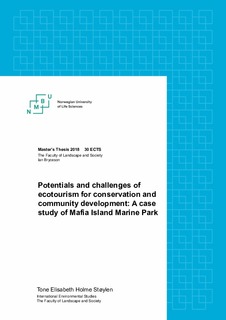| dc.description.abstract | Ecotourism is one of the fastest growing segment within tourism, and are often used as a strategy in protected areas to generate revenues for conservation and management of the protected areas. As coral reefs and marine life are facing increasing pressure from destructive harvesting methods and global warming, marine parks have been established to protect and conserve sensitive ecosystems. However, such areas are often a home for local communities where they are depended on the natural resources. The establishment of protected areas where local communities resides are often complicated and requires broad involvement of all local residents. This study examines the relationship between the Mafia Island Marine Park (MIMP), tourism and the local community, by utilizing the framework of Ross and Wall (1999a) to conceptualize and evaluate ecotourism, and determine the current level of ecotourism within the marine park. MIMP was created in 1995 after much protesting from community leaders about increased destructive fishing methods by residents outside of Mafia. The park was the first marine protected area in Tanzania, and had the intention to be a premier example of community-based conservation and development project. However, the objectives of community involvement were eventually not fulfilled in the further development of the park. This study focused on the core area of tourism in MIMP, more specifically, Utende and Utende Village. The local authorities, the tourism industry and the local community of Utende were identified, and in-depth semi-structured interviews were conducted to investigate their previous experiences and future prospects of tourism and conservation in MIMP. The relationship between local community and MIMP were assessed by looking at the resource use natural resources, local attitudes towards conservation and relations between park staff and residents. The relationship between local community and tourism were exploring the local attitudes towards tourism, economic benefits from tourism, negative impacts from tourism, economic leakage, benefits from tourism, and intercultural exchanges opportunities. Assessing the relationship between MIMP and tourism were including factors such as revenues generated for conservation, environmental education opportunities, Environmental Impact Assessment (EIA), and management and policies. This study reveals that MIMP have created limited involvement of the local community in decision-making concerning both tourism development and conservation. However, the local community have positive attitude towards tourism development with the hope of more job opportunities and community development, and recognizes the importance of conservation of the park as tourism is dependent on the natural areas. | nb_NO |

